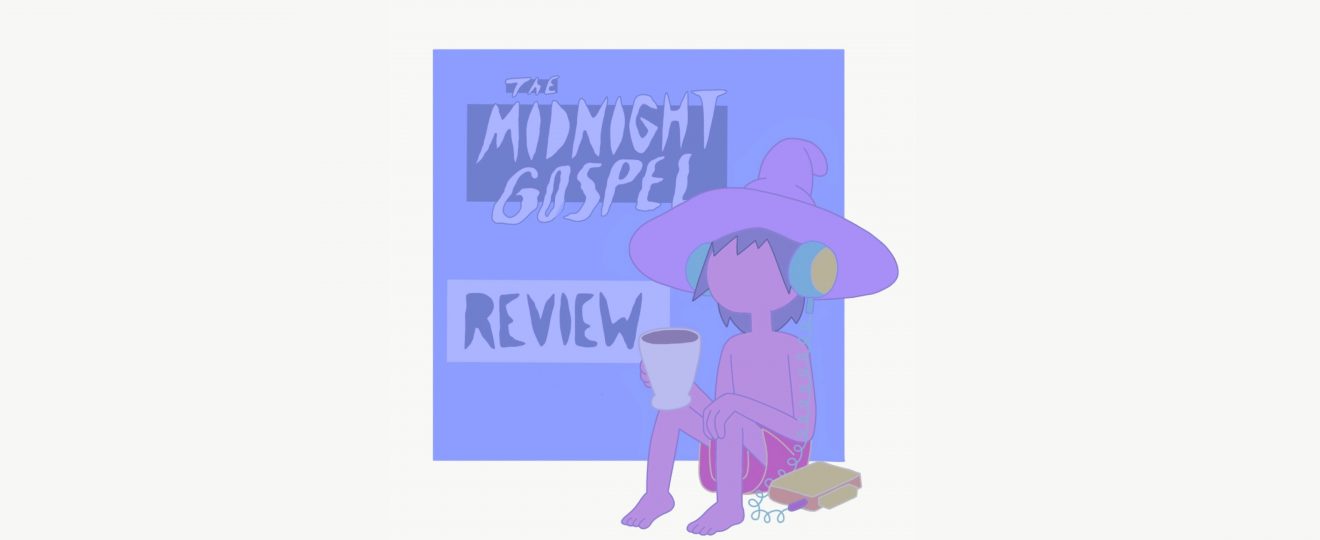Midnight Gospel is a special kind of TV show. It is as unique as I believe a show can get in the current climate of television saturation. Superficially it is special for two reasons: it is an animated show created by Pendleton Ward, the mastermind behind the beloved cartoon Adventure Time, and it is an animated show which creates its visuals based around (but also completely detached from) a series of conversations which were a part of Duncan Trussell’s podcast. It’s an unfamiliar concept, and as a result it takes some adjusting to, but the results are phenomenal and deeply provocative.
Essentially, the show’s creators took a number of podcasts in which Trussell interviews various guests and facilitates a conversation about a myriad of themes: positivity surrounding death and grieving, magic, positive and negative effects of drug use amongst them. If you were to close your eyes whilst watching the show, it would naturally feel as though you were listening to an interesting and thought-provoking conversation (bar a few moments). The creators selected specific moments from each podcast and animated the show around this. However, the animation itself is a far cry from the conversations we are listening to.

The concept that ties these conversations together is that Clancy (Duncan Trussell’s animated character) is a spaceman who interviews different creatures from different planets (the podcast guests) for his ‘space-cast’. This idea gives the animators and creators an immense and impressive amount of creative freedom to create a bizarre, disturbing, often comedic visual story. Clancy will visit a planet populated by, for example, deer-dogs and baby clowns (found in episode two, perhaps the least enjoyable or exciting, but one of the most visually weird and disturbing). Trussell and his guests have retroactively added dialogue to the conversations which is seamlessly integrated into the audio, dialogue which refers to the visuals we see on screen in order to ground the conversation a bit more in the animation. This is effective, in that it encourages you to forget that you are listening to a podcast and helps to join the audio and visuals together in a more unified experience.
I had no prior knowledge of this concept when I began watching the show – I was a fan of Adventure Time and that was a good enough reason to try Midnight Gospel. It took me a while to clock that something was different, that this show was more concept than narrative driven. The first episode is a conversation between Clancy and the president of the USA whilst they fight for survival in a zombie apocalypse and is also a conversation between Duncan Trussell and Drew Pinsky (Dr Drew) about positive and negative forms of drug use. Watching the episode, I slowly began to get the feeling that I was listening to something unscripted and genuine, a real conversation between two intelligent individuals about a topic that I had never spent much time considering. Part way through the episode I investigated the show and realised quite how unusual it was – I think I began enjoying it even more after that.
The visuals are stunning, and sometimes (particularly if you are a visual person) it feels like the conversation is distracting you from everything that is happening on-screen. At one point, whilst watching an episode together, my boyfriend muted the sound to demonstrate how different an experience just watching the screen can be (and how immersive this silent animation is). This agitated me, because I felt like I was missing out if I wasn’t listening to every word the characters were saying. Of course, that’s because I am used to more standard television, in which dialogue and visuals are used to propel a story along and are completely in sync with one another. This dialogue has to be short and snappy, in order to hold our attention and almost every line must be important. In Midnight Gospel, there is no story to push forward and little scripted dialogue, and the reality is that a lot of what is said may bore you, or you might zone in and out of the conversation, or even allow your own thoughts (inspired by their words) to take over.
Although it rubbed me the wrong way, my boyfriend’s decision to mute the interview briefly was a good one. The experience of watching Midnight Gospel without the dialogue was surreal and unique. The animation is so exciting, constantly moving and doing something unexpected and often truly amusing, that it could have been released as a series of silent animations. This is a world of pure imagination that we are entering, and it is so much wackier and more wonderful because it is the product of the collective imagination of the ridiculously talented creators and animators. If my discussion of the concept behind the show is off-putting, Midnight Gospel is worth a watch for the animation alone.
Similarly, not every episode will interest you – some episodes (in particular the finale) are deeply moving and memorable, and others are only sporadically interesting. Not every guest on Trussell’s podcast will be as interesting to you (or to anyone), not every topic of conversation will be as thought-provoking. One reviewer wrote that “it’s like watching a psychotic lava lamp while listening to your college roommate wax on and on after a week of Philosophy 101 and a few rounds of stacking bong hits.” (David Trumbore, Collider). He may have been joking, but this statement does reflect my early feelings when watching the first episode, ignorant of the concept behind it. However, there is a beauty in what these self-indulgent philosophical conversations achieve: they force the reader to let go of a need for narrative, for progression, and encourage a more thoughtful and introspective approach to watching television. Whilst I was keen to cling on to any form of plot the show offered, I had to learn to detach myself from this compulsive need and focus on the conversation being had and the jaw-dropping animation. It allowed me to sometimes just watch, and sometimes just listen, and sometimes just think inside my own head. The resulting experience was more thoughtful and provocative than most television I consume nowadays.
Art by Quinn Fagersten




